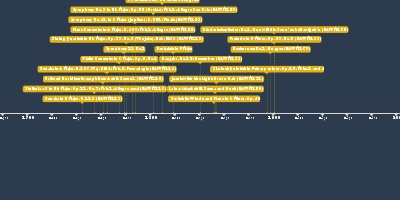1 gen 1830 anni - Symphonie fantastique: Mvt. 5, “Dream of a Witches’ Sabbath” (NAWM 138)
Descrizione:
Composer: Hector BerliozGenre: Symphony
Background
Berlioz was at this time deeply affected by German Romanticism, especially Goethe’s Faust and Beethoven’s symphonies. The original title was An Episode in the Life of an Artist, Fantastic Symphony in Five Parts.
Berlioz wrote a detailed program for the symphony, distributing it to the audience and printing it with the score. He likened the program to the text of an opera (inspired and explained the symphony’s music in like a libretto for an opera). His story was inspired by his own infatuations with English actress Harriet Smithson.
Mvt. 1: "Dreams and Passions"
Fast sonata form with a long, slow introduction
Summary of program notes:
A young musician meets the woman of his dreams and falls madly in love with her. Her melodic theme is passionate, yet mobile and shy, just as the musician perceives her to be. This melody becomes an obsession (idee fixe) for the young musician, haunting him throughout all five movements. This movement is focused on initial inclinations and emotion, including delirious passion steeped with fury and jealousy along with returns to tenderness.
The idee fixe is gracious, but full of leaps and yearning.
Mvt. 2: "A Ball"
A dance, though a lopsided waltz (in 5) instead of the typical minuet.
Summary of program notes:
The artist is placed in many varied circumstances (a bustling ball or calm contemplations), but the beloved’s theme yet pervades his thoughts, causing confusion in his heart.
Mvt 3: "Scene in the country"
Slow movement
Summary of program notes:
The musician is in the country and hears the communications between two distant shepherds while also trying to decipher his own internal feelings. He hopes to no longer be alone, but fears that she may have misled him. At the end, one of the shepherds does not respond and the movement collapses into itself in solitude and isolation, ending in silence.
Mvt 4: "March to the Scaffold"
March (the extra movement)
Summary of program notes:
He poisons himself with opium, convinced his love is unrequited. The opium causes a vision-filled sleep rather than death, in which he kills his beloved instead of himself and is being marched to the scaffold, proceeding to witness his own execution. The procession is at times dark and savage, and at other times brilliant and solemn.
Mvt 5: "Dram of a Witches’ Sabbath"
Fast finale
Summary of program notes:
He imagines himself witnessing his own funeral among supernatural beings such as ghosts and monsters. The scene is permeated with grotesque noises and cries calling out to one another. The beloved’s theme returns, but has lost its character of nobility and shyness; it is no more than a wretched, commonplace, and grotesque dance tune. There are roars of joy at her arrival and she joins in the diabolical orgy. Finally, the Sabbath round dance and a burlesque parody of Dies Irae are played together.
The idee fixe is mocked by being played in a fast 6/8 time, embellished with gracenotes and trills. Also, the strings play with col legno (striking the string with the wood of the bow) to imitate the rattling bones of dancing skeletons.
Aggiunto al nastro di tempo:
Data:
1 gen 1830 anni
Adesso
~ 195 years ago
